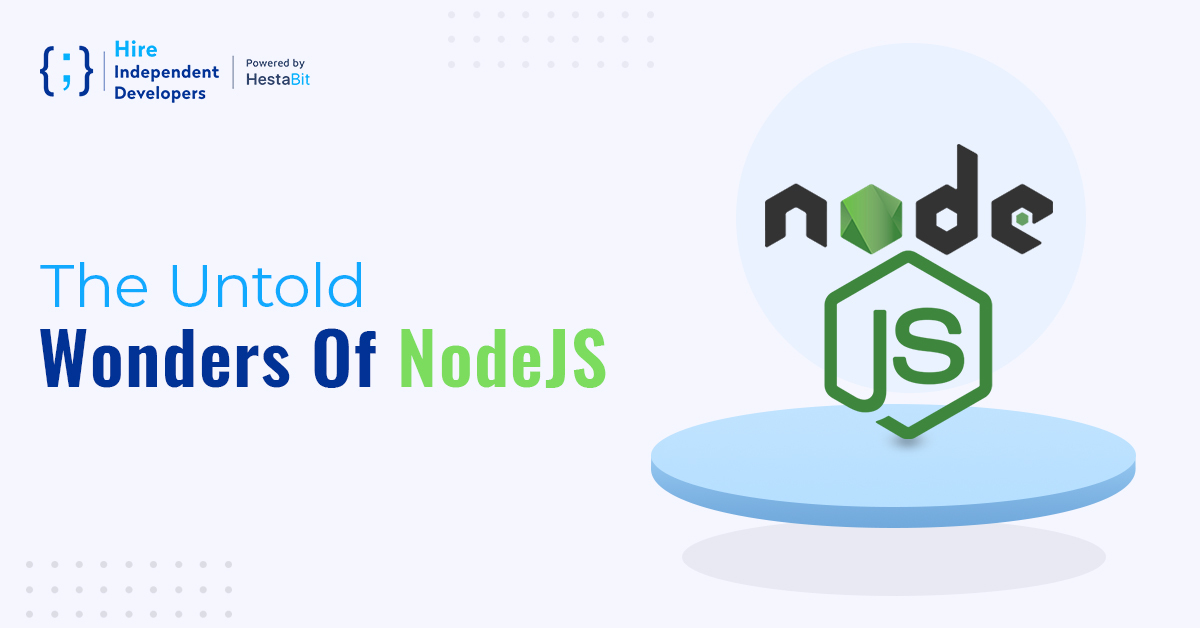Imagine visiting Netflix and waiting for it to load your suggestions just because millions of users are requesting before you. Only If there could be a way to run thousands of requests at once. Ever wondered how web applications like Uber, PayPal, LinkedIn, and Yahoo run globally without any delay or server instance, giving you the best ever user experience?
It is all on NodeJS web app development that can run multiple operations for you concurrently. NodeJS has set an unmatchable standard for application development that has no competition.
NodeJS is a part of Javascript, and we all know how JS has dominated the web development industry for years. JS alone is responsible for Facebook, Google, Wikipedia, and a majority of all online pages for client-side operations. It is no more just a front-end tool; the technology has shifted to cross-platform mobile development and back end with NodeJS. Now developers are looking to use the same tech stack for the entire web project without learning a new language for server-side development.
NodeJS is that one tool that adapts JS functionality and syntax to the back-end. Looking at all the headlines and popularity NodeJS is gaining these days, it is crucial we learn everything about NodeJS. Right from its basic features to benefits to all good and bad, NodeJS will do to your application development.
So what are we waiting for? Let us dive into the world of NodeJS today.
In this article, we will talk about
- What is NodeJS?
- What do you need to get started with NodeJS?
- Advantages of NodeJS?
- What are the disadvantages of NodeJS?
- Famous applications built on NodeJS?
- The future of NodeJS.
What is NodeJS?
Before I define NodeJS for you, remember that it is not a library, it is not a framework, and it is definitely not a programming language. NodeJS is an open-source and cross-platform runtime environment that executes Javascript code outside a browser.
Enterprises usually hire NodeJS developers for building back-end services such as APIs for web apps or mobile apps. If we notice, NodeJS consequently represents a Javascript everywhere paradigm and plays a major role in unifying web application development across a single programming language, rather than multiple languages for client-side and server-side scripts.
Ryan Dahl wrote NodeJS in the initial months of 2009, right about thirteen years after the introduction of the Javascript environment, “Netscape’s Livewire Pro Web.” The commencing release of NodeJS supported only Linux and Mac OS X. Further, Dahl supported its development and maintenance and eventually made it accessible to almost all the major operating systems. Unlike Ruby on Rails and PHP, NodeJS has an event-driven, non-blocking I/O model, which makes it an excellent choice to build dynamic and scalable applications.
And saving the best feature for the end, NodeJS is developed on Javascript’s V8 engine that can run in Chrome, other browsers, and even stand alone. That’s how it broadens the functionality of JS and allows developers to integrate the language with several APIs and other external libraries.
What Do You Need To Get Started With NodeJS
If you are looking to pursue your projects with NodeJS, here’s what you need to do. To start working with NodeJS, you would require to install the runtime environment itself along with an integrated development environment, Node package modules, and frameworks.
NodeJS files:
You can start by downloading the latest version of the environment for macOS or windows. You will find NPM (Node Package Manager) comes in the package to install additional features and get access to recent modules. To know more about the installation process, you can take help from its official guide.
Official documentation:
In case you are unfamiliar with the language’s functionality and syntax, seek help from the official library. There, you will find guides to simple tasks such as typing “Hello World” and a detailed overview of basic as well as advanced functionalities.
IDEs supporting NodeJS:
Generally, a lot of code editors are well versed with NodeJS, but the best IDEs (Integrated development environment) supporting NodeJS are Atom, VS Code, Web Storm.
NodeJS frameworks:
NodeJS frameworks offer automation features, libraries, templates, and display interfaces that make the development process easier than ever. Currently, highly recommended NodeJS frameworks in the market are Koa.JS, Meteor, and ExpressJS, among others.
Now before I take you to the benefits of NodeJS, let us get a general outlook on some of the significant features of NodeJS.
Here is what makes NodeJS different from others:
- NodeJS can be used for agile development and prototyping; hence, easy to get started with.
- NodeJS is chosen for its fast and highly scalable services.
- NodeJS facilitates Javascript literally everywhere; therefore, it’s easy for a Javascript programmer to build back-end services using NodeJS.
- NodeJS provides an extensive and massive ecosystem for open source libraries.
- The source code for NodeJS is cleaner and consistent.
- And we already know its asynchronous and non-blocking nature.
Pros and Cons of Node JS
The pros and cons of NodeJS can be a subject of heated discussion. Therefore, to set the record straight, I have analyzed both in an attempt to find what projects can work best with this technology. Hence, below are some of the major NodeJS advantages and disadvantages:
Advantages of Node JS :
Robust technology stack
Among some of the most popular programming languages, Javascript has proven to be an undisputed leader. In that context, NodeJS is a stand-alone name in the industry. NodeJS currently has more than 5 million downloads and over 1000 new contributors worldwide. When you use NodeJS for the back-end, you automatically leverage the pros of Javascript development, such as :
- Reuse and code sharing
- Performance and speed
- Number of free tools
- Efficiency and developer productivity
- Effective knowledge sharing within your team
Even the trained front-end developers can program the server-side with minimal effort. Using the same language on both sides, one can reuse the code on the back-end and the front end by wrapping it into modules and creating new levels of abstraction.
Fast processing and event-based model
NodeJS being fast is not a myth. If you take a look at the performance tests of PHP, Java, Go, and NodeJS, you would see how this handles the maximum concurrent requests. There are several reasons for its outstanding performances.
- V8 engine – The engine employed in NodeJS implementation was originally created for the Chrome browser. Chrome’s V8 is written in C++ that is primarily used to compile functions written in Javascript into machine code. The engine does its job at an impressive speed. All the credit goes to Google who invested heavily in its engine. Every year the V8 engine demonstrates distinctive performance, and NodeJS takes the most out of it.
- Asynchronous request handling and Non-blocking Input/Output
NodeJS has the capacity to process requests without any delays. Regarding the back-end, synchronous processing automatically assumes that the code is executed in a sequence. This leads to each request blocking a thread so that other requests can finish first.
Further, asynchronous processing allows requests to proceed without blocking the thread. This way, after a request is processed, a callback can be pushed out and hence can continue serving requests. This entire process helps NodeJS to take most out of single threading, which results in short response time and concurrent processing.
Another reason is its event-based model. When we use a common language for both the server and client-side, the synchronization process fastens, which is the source of smooth real-time applications. Enterprises for online gaming, video conferences, chats, or any other category that requires quick data processing choose NodeJS over any other technology.
Many high-profile enterprises migrated to NodeJS after noticing its significant improvements, like PayPal. The company noticed a 35 % decrease in its response time after shifting from Java.
Scalable technologies for microservices
NodeJS is ideal for microservice architecture since it’s a lightweight technology tool. Instead of developing a single, large monolithic core, NodeJS breaks the application logic into smaller modules called microservices that lays the groundwork for further growth and enables better flexibility. As a result, it gets much more accessible to add more microservices along with the existing ones.
NodeJS is the technology of choice when deploying and building microservices ecosystem solutions, and about half of the respondents utilize microservice-related technology to build NodeJS web applications.
- For instance, let us see the transformation in Walmart after shifting to microservice architecture with NodeJS.
- Walmart experienced over 98% mobile conversion growth and an overnight 20% conversion growth in general.
- The company also saw one hundred percent uptime on Black Friday, which means handling about 500 million page views.
- Thus, the company saved up to 40% on hardware and 20-50% on overall operations.
Rich Ecosystem
The default NodeJS package manager, npm, acts as a marketplace for open source Javascript tools, which is a significant aspect for advancement in technology. Currently, 8,36,00 libraries are available in the NPM registry. With such massive availability of tools in a few clicks, NodeJS has excellent potential in the ecosystem.
Strong corporate support
Joyent supported the development of NodeJS. Today, the list of organizations using NodeJS in their development process is continuously growing. This is how NodeJS has outshined in the software industry since its release.
Seamless JSON support
There are several other back-end technologies such as PHP and Ruby on Rails that use the JSON format for communication; however, NodeJS does it without changing between binary models. This comes in handy, especially when you need to build easy APIs for NoSQL database support. This smooth communication with such data transfer standards is an excellent advantage of the NodeJS ecosystem.
With all the advantages, NodeJS also comes with certain drawbacks:
Heavy Computation tasks:
Sometimes when NodeJS receives a CPU-bound task, it processes the entire CPU to handle that request first and leaves other requests on queues. This might result in slow processing and a delay in the loop. However, this only occurs once in a blue moon when the traffic is massive.
Tooling Immaturity
Another small con of NodeJS is in its npm registry. Although NodeJS is a stable technology, there are specific tools in the npm registry that compromise quality. This can unstructure the registry and might affect the application’s interface. But again, this is a very small issue under endless NodeJS benefits.
Popular Apps Built with Node JS:
Netflix
Netflix is the world’s largest video streaming platform containing movies, television series, and documentaries with availability in over 190 countries. The NodeJS technology has proved so effective for the company that it is planning to use the technology in other layers of the stack as well.
LinkedIn is a popular business-oriented social networking application established in 2002. The application uses NodeJS in order to empower its server-side of the mobile app.
Uber
A multinational American online transportation that offers its service in over 900 cities and 80 countries. Uber uses NodeJS in its full production with a fantastic matching system.
GoDaddy
GoDaddy is an internet public domain registrar and web hosting company. Currently, the company has approximately 20 million customers and 61 million domains under its management. GoDaddy has dedicated its entire back-end to NodeJS.
eBay
eBay is a multinational eCommerce company that provides business-to-consumer and consumer-to-consumer internet sales services. The company now has 182 million active users. eBay uses NodeJS for its performance, simplicity, and scalability.
Know More: Build Your Next eCommerce Store with NodeJS
The Future Of NodeJS
Javascript is omnipresent in both the server as well as the browser, and all the credit goes to NodeJS web development, the technology that makes high-end enterprises hire NodeJS developers to make anything possible. NodeJS has already proved its worth in the software industry with its extraordinary features and applications. This technology will remain ahead among all others for web-based and mobile-based back-end systems in the coming years. Therefore, the future of NodeJS is bright and shining.





